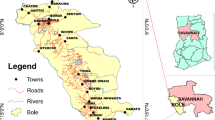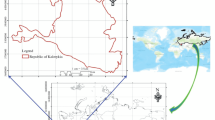Abstract
Artificial groundwater recharge plays a vital role in sustainable management of groundwater resources. The present study was carried out to identify the artificial groundwater recharge zones in Bist Doab basin of Indian Punjab using remote sensing and geographical information system (GIS) for augmenting groundwater resources. The study area has been facing severe water scarcity due to intensive agriculture for the past few years. The thematic layers considered in the present study are: geomorphology (2004), geology (2004), land use/land cover (2008), drainage density, slope, soil texture (2000), aquifer transmissivity, and specific yield. Different themes and related features were assigned proper weights based on their relative contribution to groundwater recharge. Normalized weights were computed using the Saaty’s analytic hierarchy process. Thematic layers were integrated in ArcGIS for delineation of artificial groundwater recharge zones. The recharge map thus obtained was divided into four zones (poor, moderate, good, and very good) based on their influence to groundwater recharge. Results indicate that 15, 18, 37, and 30 % of the study area falls under “poor,” “moderate,” “good,” and “very good” groundwater recharge zones, respectively. The highest recharge potential area is located towards western and parts of middle region because of high infiltration rates caused due to the distribution of flood plains, alluvial plain, and agricultural land. The least effective recharge potential is in the eastern and middle parts of the study area due to low infiltration rate. The results of the study can be used to formulate an efficient groundwater management plan for sustainable utilization of limited groundwater resources.












Similar content being viewed by others
References
Aggarwal R, Kaur S, Juyal D (2009a) Micro level assessment of water resources in bist doab tract of Indian Punjab. J Agric Eng 46(2):33–39
Aggarwal R, Kaushal M, Kaur S, Farmaha B (2009b) Water resource management for sustainable agriculture in Punjab. India. Water Science and Technology 60(11):2905–2911
Anbazhagan S, Ramasamy SM, Das Gupta S (2005) Remote sensing and GIS for artificial recharge study, runoff estimation and planning in Ayyar basin, Tamil Nadu, India. Environ Geol 48(2):158–170
Chawla JK, Khepar SD, Sondhi SK, Yadav AK (2010) Assessment of long-term groundwater behaviour in Punjab, India. Water Int 35(1):63–77
Chenini I, Mammou AB, May ME (2010) Groundwater recharge zone mapping using GIS-based multi-criteria analysis: a case study in Central Tunisia (Maknassy Basin). Water Resour Manage 24(5):921–939
Chowdhury A, Jha MK, Chowdary VM (2010) Delineation of groundwater recharge zones and identification of artificial recharge sites in West Medinipur district, West Bengal, using RS, GIS and MCDM techniques. Environ Earth Sci 59(6):1209–1222
ESRI (2009). ArcGIS 9.3.1. ESRI (Environmental Systems Research Institute), Redlands
Ghayoumian J, Ghermezcheshmeh B, Feiznia S, Noroozi AA (2005) Integrating GIS and DSS for identification of suitable areas for artificial recharge, case study Meimeh Basin, Isfahan, Iran. Environ Geol 47(4):493–500
Hira GS (2009) Water Management in Northern States and the Food Security of India. J Crop Improv 23(2):136–157
Jaiswal RK, Mukherjee S, Krishnamurthy J, Saxena R (2003) Role of remote sensing and GIS techniques for generation of groundwater prospect zones towards rural development—an approach. Int J Remote Sens 24(5):993–1008
Jha MK, Chowdhury A, Chowdary VM, Peiffer S (2007) Groundwater management and development by integrated remote sensing and geographic information systems: prospects and constraints. Water Resour Manage 21(2):427–467
Kaur S, Aggarwal R, Soni A (2011) Study of water-table behaviour for the Indian Punjab using GIS. Water Sci Technol 63(8):1574–1581
Mukherjee P, Singh CK, Mukherjee S (2012) Delineation of groundwater potential zones in arid region of India—A remote sensing and GIS Approach. Water Resour Manage 26(9):2643–2672
NRSA. (2008). Groundwater prospect mapping using remote sensing and GIS, Rajiv Gandhi National Drinking Water Mission Project Manual. National Remote Sensing Agency, Hyderabad
Ravi Shankar MN, Mohan G (2005) A GIS based hydrogeomorphic approach for identification of site-specific artificial-recharge techniques in the Deccan Volcanic Province. J Earth Syst Sci 114(5):505–514
Rodell M, Velicogna I, Famiglietti JS (2009) Satellite-based estimates of groundwater depletion in India. Nature 460:999–1002
Saaty TL (1980) The analytic hierarchy process: planning, priority setting, resource allocation. McGraw-Hill, New York, p 287
Saraf AK, Choudhury PR (1998) Integrated remote sensing and GIS for groundwater exploration and identification of artificial recharge sites. Int J Remote Sens 19(10):1825–1841
Singh CK, Shashtri S, Singh A, Mukherjee S (2011) Quantitative modeling of groundwater in Satluj River basin of Rupnagar district of Punjab using remote sensing and geographic information system. Environ Earth Sci 62(4):871–881
Solomon S, Quiel F (2006) Groundwater study using remote sensing and geographic information system (GIS) in the central highlands of Eritrea. Hydrogeol J 14(5):729–741
Tiwana NS, Jerath N, Ladhar SS, Singh G, Paul R, Dua DK, Parwana HK (2007) State of Environment; Punjab-2007, Punjab State Council for Science & Technology, p 243
Tsakiris G (2004). Water resources management trends, prospects and limitations. Proceedings of the EWRA symposium on water resources management: risks and challenges for the 21st century, Izmir, 2–4 September 2004, pp 1–6
Acknowledgments
The authors are very grateful to Punjab Remote Sensing Centre, Ludhiana, National Bureau of Soil Survey and Land Use Planning (NBSS–LUP), Nagpur, Geological Survey of India (GSI), Chandigarh, Central Ground Water Board (CGWB) for providing the necessary data.
Author information
Authors and Affiliations
Corresponding author
Rights and permissions
About this article
Cite this article
Singh, A., Panda, S.N., Kumar, K.S. et al. Artificial Groundwater Recharge Zones Mapping Using Remote Sensing and GIS: A Case Study in Indian Punjab. Environmental Management 52, 61–71 (2013). https://doi.org/10.1007/s00267-013-0101-1
Received:
Accepted:
Published:
Issue Date:
DOI: https://doi.org/10.1007/s00267-013-0101-1




